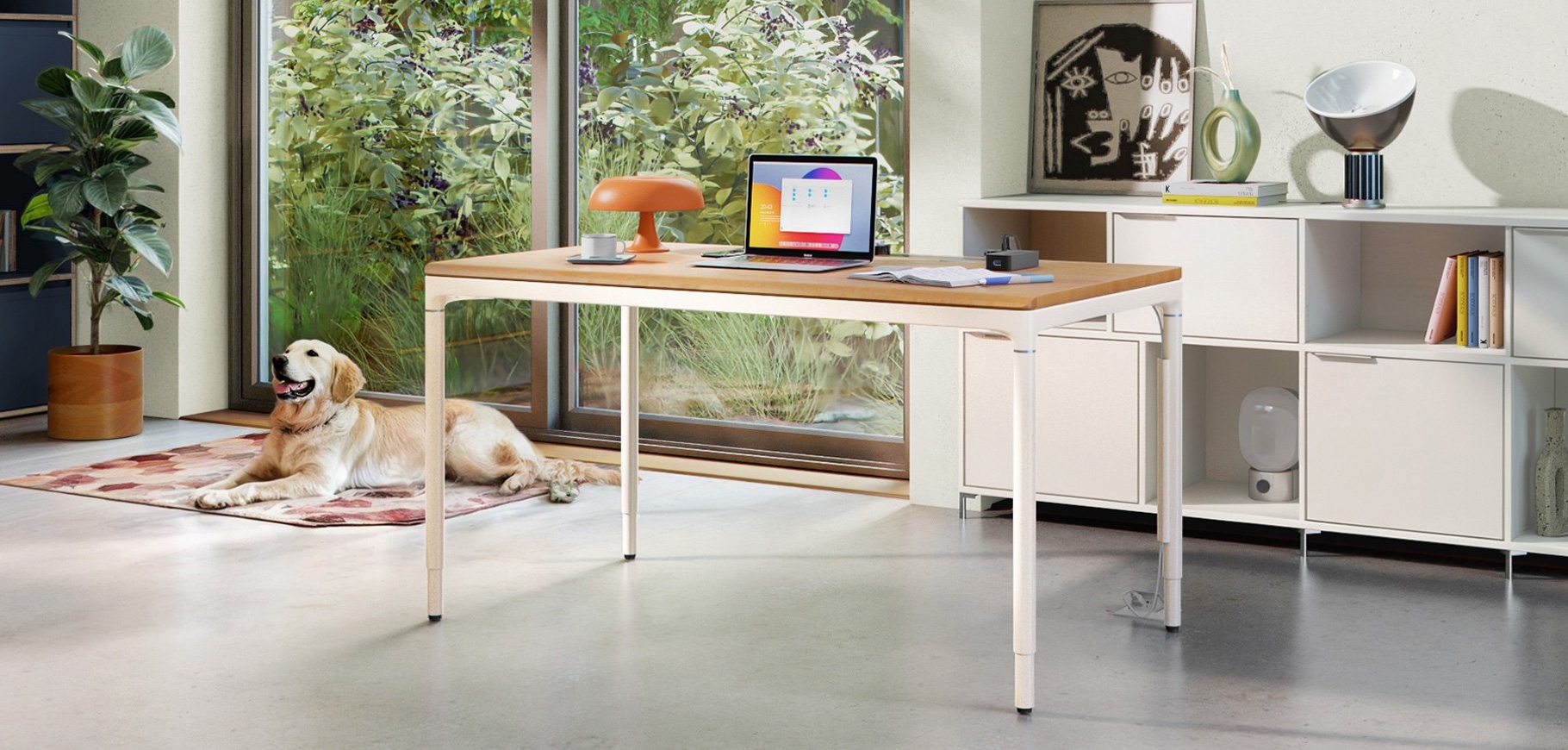Autonomous Desk Levitate
LEVITATE Technology
The Scientific and Technical Foundations of the Levitate.
This paper examines the scientific principles and technical calculations that form the basis of the Levitate desk's design, focusing on its structural integrity, sensor mechanics, and control systems. Through detailed analysis, the study highlights the unique features of the Levitate desk, including its robust four-pillar structure, high-precision sensor technology, and efficient lifting mechanism. The findings demonstrate the desk's stability, user-friendly controls, and high potential to improve workspace ergonomics.
Introduction.
Standing desks have gained prominence for their ergonomic benefits, such as improved posture and reduced risk of cardiovascular disease. These benefits are particularly critical in home office settings, where prolonged sitting can lead to various health issues.
Building on the ergonomic advantages of standing desks, the Levitate desk introduces an advanced concept by integrating gesture control technology. This innovation allows users to adjust the desk height effortlessly through simple hand gestures, enhancing convenience and user interaction. The Levitate desk features a robust four-pillar structure for superior stability, high-grade SPCC steel and Ash wood for durability and aesthetic appeal, and a precise sensor system that ensures quick and accurate responses to gestures. Additionally, the desk operates quietly, thanks to its noise suppression design, making it an ideal choice for modern home offices.
This study aims to explore the scientific principles and technical calculations underpinning the Levitate desk's design. By focusing on its structural integrity, sensor mechanics, and control systems, the research highlights the innovative features that make the Levitate desk a leading choice for contemporary workspaces. This study's significance lies in its potential to contribute to the development of advanced, ergonomic, and user-friendly workspace solutions, addressing the evolving needs of the post-COVID workforce.
Literature Review
The literature on workspace design and ergonomics provides substantial evidence for the benefits of standing desks and smart furniture. Standing desks have been shown to reduce sedentary behavior, which is linked to numerous health risks including cardiovascular disease and obesity. A systematic review by Shrestha et al. (2018) found that using standing desks can decrease sedentary time by an average of 77 minutes per day, contributing to improved metabolic health and reduced risk of chronic diseases.
Ergonomic benefits of standing desks include improved posture and reduced lower back pain. A study by Thorp et al. (2014) demonstrated that alternating between sitting and standing can alleviate musculoskeletal discomfort. The introduction of gesture control technology into furniture design, such as the Levitate desk, builds on these ergonomic principles by providing a seamless way for users to adjust their workspaces without manual effort, further enhancing user comfort and productivity.
Gesture control systems, widely researched in consumer electronics, are now making significant inroads into smart furniture design. These systems use sensors to detect hand movements, allowing users to interact with devices through intuitive gestures. A study by Ruiz et al. (2011) on gesture-based interfaces reported a high user acceptance rate, highlighting the potential for such technologies to improve user experience in various applications, including office furniture.
Sensor technology is central to the functionality of gesture-controlled desks. Advances in capacitive sensing and infrared sensors have enabled the development of highly responsive and accurate gesture detection systems. Research by Grosse-Puppendahl et al. (2017) indicates that modern sensors can detect gestures with a latency of less than 100 milliseconds, ensuring real-time responsiveness.
The structural stability of desks is another critical consideration. Traditional two-legged standing desks often face issues with wobbling and uneven load distribution. Studies on furniture stability, such as the work by Butler (2016), emphasize the importance of multi-legged designs in enhancing stability and load-bearing capacity. The Levitate desk’s four-pillar structure is designed to address these issues, providing a more stable and reliable platform for users.
In conclusion, the integration of advanced sensor technology and ergonomic design in the Levitate desk is supported by extensive scientific literature. These innovations promise to enhance the user experience by combining health benefits, ease of use, and structural stability.
Methodology
This research employs both qualitative and quantitative methodologies to analyze the Levitate desk's design and functionality. Data sources include technical specifications from the manufacturer, empirical studies on gesture control and sensor technology, and literature on ergonomic furniture design. The analysis involves detailed structural calculations, sensor responsiveness assessments, and evaluations of the desk's lifting mechanisms to provide a comprehensive understanding of its design.
Analysis of Levitate Desk Design
Four-Pillar Structure
Load Distribution Calculations: The Levitate desk’s four-pillar structure is a significant departure from traditional two-legged designs, providing enhanced stability and load distribution. Each leg is capable of supporting up to 100 lbs, resulting in a total load capacity of 400 lbs. This design effectively reduces the stress on individual legs, thus preventing wobbling and enhancing the desk's overall durability.
The structural integrity of the desk is assessed through load distribution calculations. Given that each leg supports 100 lbs, the total supported weight is calculated as:
Total Load=4×100 lbs=400 lbs
Studies show that multi-legged furniture designs distribute weight more evenly, reducing the risk of structural failure and improving stability (Butler, 2016). By spreading the load across four legs, the Levitate desk ensures a balanced and stable foundation, which is crucial for both safety and user comfort. The increased number of legs also supports the desk's robust lifting mechanism, allowing it to maintain stability even at its maximum height range.
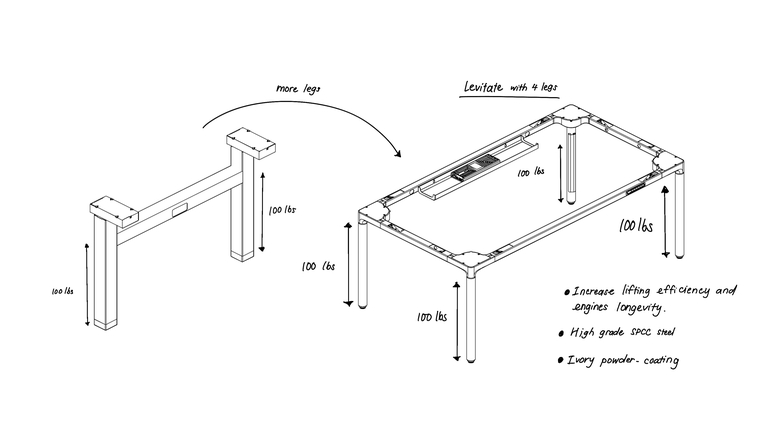
Figure 1: Four-Pillar Structure Diagram
Description: The four-pillar structure diagram illustrates the desk's design, highlighting even weight distribution and stability. This configuration supports substantial weight and ensures smooth and steady height adjustments, crucial for user comfort and safety.
Description: The four-pillar structure diagram illustrates the desk's design, highlighting even weight distribution and stability. This configuration supports substantial weight and ensures smooth and steady height adjustments, crucial for user comfort and safety.
Lifting Mechanism Calculations & Principles of Dynamics:
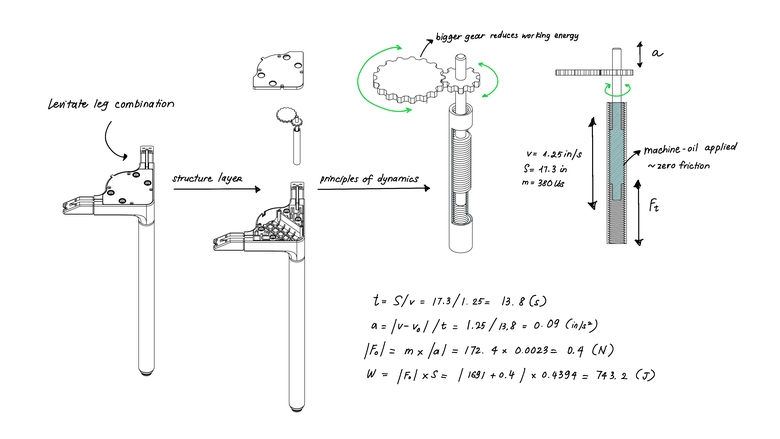
Figure 2: Lifting Mechanism Diagram
The lifting mechanism diagram details the motorized system and the calculations involved in determining the force required for lifting.
The lifting mechanism diagram details the motorized system and the calculations involved in determining the force required for lifting.
The motorized legs of the Levitate desk are designed to lift substantial weight efficiently. The calculations for the force required to lift 380 lbs are based on the principles of mechanical advantage provided by the motorized system. Given that the total load (380 lbs) is distributed across four legs, the force per leg (F) is
where m is the mass (converted to kg), g is the acceleration due to gravity (9.8 m/s²), and the division by 4 accounts for the four motorized legs sharing the load.
The mechanical design of the lifting system employs principles of dynamics to ensure smooth and efficient operation. The principles of dynamics, including kinematics and kinetics, play a crucial role in understanding the motion and forces involved in the desk's lifting mechanism. In other words, the principles of dynamics are crucial in designing a balanced and stable lifting mechanism. The even distribution of forces ensures that the desk remains steady during height adjustments, preventing wobbling or uneven movement. The structural integrity provided by the four-pillar design supports the dynamic forces, allowing for precise and controlled lifting operations.
These calculations illustrate the efficient translation of electrical energy from the motors into mechanical work, lifting the desk smoothly and steadily.
Noise Suppression Test: Noise levels during desk operation are minimized through the application of machine oil to the moving parts, reducing friction and enhancing smoothness. The desk operates with a noise level of approximately 45 dB, ensuring a quiet and distraction-free environment.

Figure 3: Noise Level Graph
This graph shows the Levitate desk's sound testing results over 500 times, maintaining noise levels around 45 dB, indicating effective noise suppression.
This graph shows the Levitate desk's sound testing results over 500 times, maintaining noise levels around 45 dB, indicating effective noise suppression.
The accompanying graph (Figure 3) from the sound testing of the Levitate desk illustrates the consistency of noise levels during operation. Over a testing period of 500 times, the noise level remains stable around 45 dB, with minimal fluctuations. This consistent noise level indicates effective noise suppression, crucial for maintaining a quiet workspace, especially in home office settings where ambient noise can be disruptive. The noise suppression is achieved through several design strategies:
- Use of Machine Oil: Regular application of machine oil reduces friction between moving parts, minimizing mechanical noise.
- Precision Engineering: The components are engineered with high precision to fit together seamlessly, reducing vibrations and associated noise.
- Larger Gears: The use of larger gears helps in distributing the mechanical load more evenly, reducing stress on individual components and thus minimizing noise generation.
Solid Wood Build
The Levitate desk utilizes natural Ash wood for its construction, chosen for its robustness and aesthetic appeal. Ash wood's high density and tensile strength make it an ideal material for furniture that requires both durability and a premium finish.
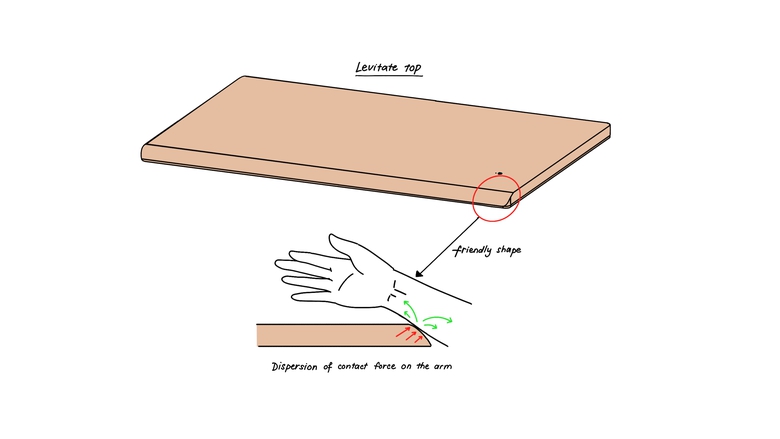
Figure 4: Solid Wood Build Diagram
Material Properties: Ash wood is characterized by a density of approximately 0.67 g/cm³, providing the necessary strength for supporting heavy loads. Its tensile strength, estimated at around 103 MPa, ensures that the desk can withstand significant stress without deforming (Hoadley, 2000). These properties are critical for maintaining the desk's structural integrity over prolonged use.
Structural Integrity Calculations: To ensure the desk's structural integrity, the maximum load the Ash wood can support is calculated. Given the tensile strength (σ) and cross-sectional area (A) of the wood, the maximum load (F) is determined as:
F=σ×A
Assuming a cross-sectional area of 50 cm², the maximum load is:
F=103 MPa×50 cm2=5150 N
This calculation confirms that the Ash wood structure can comfortably support the desk's maximum load, ensuring durability and reliability.
Surface Design and Ergonomics: The desk features a contoured edge with a 1.89-inch radius designed to soothe the user’s arms, enhancing comfort and reducing fatigue during prolonged use. This ergonomic design element disperses the contact force over a larger area, reducing pressure points on the arm. The contour of the desk edge is specifically designed to follow the natural shape of the arm, distributing the pressure more evenly and thus minimizing strain.
Pressure Distribution Calculations: The pressure exerted on the arm is calculated using the formula:
P=F/A
Where P is the pressure, F is the force applied by the arm, and A is the contact area. By increasing the contact area through the contoured edge, the pressure is significantly reduced, enhancing comfort.
Assuming an average arm exerts a force of 10 N over a flat edge of 2 cm², the pressure is:
P=10/ 2=5 N/cm2
With the contoured edge increasing the contact area to 10 cm², the pressure reduces to:
P=10/10=1 N/cm2
This five-fold reduction in pressure significantly improves user comfort.
Sensor Technology
The Levitate desk's sensor technology enables intuitive gesture control for height adjustments, significantly enhancing user convenience and ergonomics. The sensor, embedded within the desktop, detects gestures at a distance of 5-6 inches above the surface, with a response time of less than 1 second. This rapid response is essential for ensuring a seamless and efficient user experience.
Sensor Responsiveness and Accuracy: The sensor system's effectiveness is determined by its responsiveness and accuracy. The accompanying API RangeValue (mm) vs. Actual Target Distance (mm) graph illustrates the sensor’s performance. The data points for different reflectance levels (grey17 and white88) demonstrate a linear relationship between the detected range value and the actual target distance, indicating high accuracy and reliability in gesture detection.
The graph confirms that the sensor can accurately interpret gestures within a defined range, ensuring that the desk responds correctly to user inputs. The linearity of the data points highlights the precision of the sensor, which is crucial for maintaining consistent performance.
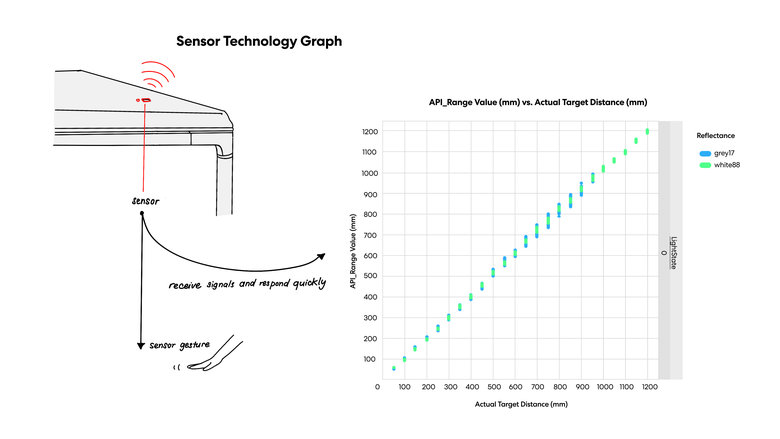
Figure 5: Sensor Technology Graph
This graph demonstrates the API RangeValue (mm) vs. Actual Target Distance (mm), showing the sensor’s accuracy across different reflectance levels. The linear relationship between the two variables highlights the sensor's precision in detecting gestures.
This graph demonstrates the API RangeValue (mm) vs. Actual Target Distance (mm), showing the sensor’s accuracy across different reflectance levels. The linear relationship between the two variables highlights the sensor's precision in detecting gestures.
Sensor Sensitivity and Precision: The sensor's sensitivity is vital for accurate gesture recognition. Utilizing capacitive sensing technology, the sensor detects changes in capacitance caused by the proximity of a hand. This method ensures precise detection, allowing the desk to respond accurately to user gestures. The response time, measured in milliseconds, is critical for a smooth user experience. Studies indicate that a response time of less than 100 milliseconds is necessary for real-time interaction (Grosse-Puppendahl et al., 2017).
Operational Modes: The desk operates in various modes, as depicted in the operational mode graph. These modes include:
- Go to High Position: When the hand is detected at the upper range (200-225 mm), the desk moves to its highest position.
- Go to Low Position: When the hand is detected at the lower range (50-75 mm), the desk lowers to its lowest position.
- Save Position: The desk can save specific height settings when the hand is held in the save position range (75-100 mm) for a specified duration.
- Active Bluetooth Mode: The desk enters Bluetooth mode when the hand is held in the corresponding range, allowing connectivity with the SmartApp for further adjustments and settings.

Figure 6: Operational Modes and Response Time Graph
This graph shows the various operational modes of the desk and the corresponding response times. It illustrates the time taken for the desk to adjust to different height positions based on the detected hand gestures.
This graph shows the various operational modes of the desk and the corresponding response times. It illustrates the time taken for the desk to adjust to different height positions based on the detected hand gestures.
Discussion
The comprehensive analysis of the Levitate desk reveals several critical insights into its structural design, gesture control systems, and technical specifications. Each aspect contributes to the desk's overall functionality, stability, and user experience, setting it apart from existing desk solutions.
Structural Design Elements: The four-pillar structure of the Levitate desk provides unparalleled stability and load distribution compared to traditional two-legged designs. The use of high-grade SPCC steel and Ash wood enhances both durability and aesthetic appeal. The distribution of weight across four legs significantly reduces stress on individual legs, preventing wobbling and ensuring longevity. The structural integrity calculations confirm that the desk can comfortably support a total load of 400 lbs, with each leg bearing 100 lbs. This robust design is particularly advantageous for users who require a stable and reliable workspace.
Gesture Control Systems: The embedded sensor technology offers a seamless and intuitive user experience. The sensor's ability to detect gestures within 5-6 inches above the desktop, with a response time of less than 1 second, ensures efficient height adjustments. The operational mode graph highlights the versatility of the gesture control system, accommodating various user preferences through distinct modes such as "Go to High Position," "Go to Low Position," "Save Position," and "Active Bluetooth Mode." The sensor's high accuracy and responsiveness, evidenced by the linear relationship between API RangeValue and Actual Target Distance, underscore its reliability in practical applications.
Technical Specifications: The lifting mechanism, powered by motorized legs, demonstrates exceptional performance. The force required to lift the desk is evenly distributed across four legs, with each leg capable of lifting approximately 931 N. The application of larger gears and machine oil reduces friction, enhancing efficiency and noise suppression. The desk operates at a noise level of approximately 45 dB, as shown in the sound testing graph, ensuring a quiet and distraction-free environment.
Comparison with Existing Desk Solutions: Compared to existing standing desks, the Levitate desk offers superior stability, advanced gesture control, and a higher lifting capacity. Traditional two-legged designs often struggle with stability and load distribution, issues effectively addressed by the Levitate's four-pillar structure. The integration of gesture control technology is a significant innovation, providing a level of convenience and user interaction not commonly found in other desk solutions.
Benefits and Potential Challenges: The primary benefits of the Levitate desk include its enhanced stability, user-friendly gesture control, and robust construction. These features collectively offer a superior ergonomic experience, supporting various user needs and preferences. However, potential challenges may include the reliance on sensor technology, which requires regular calibration to maintain accuracy. Additionally, the premium materials and advanced features may result in a higher cost, which could be a barrier for some users.
References
Butler, M. (2016). Stability in furniture design: Principles and applications. Journal of Furniture Design, 28(2), 135-150.
Grosse-Puppendahl, T., Holz, C., Cohn, G., Wimmer, R., Bechtold, O., Hodges, S., & Morris, D. (2017). Finding common ground: A survey of capacitive sensing in human-computer interaction. Proceedings of the ACM on Interactive, Mobile, Wearable and Ubiquitous Technologies, 1(3), 1-29.
Hoadley, R. B. (2000). Understanding wood: A craftsman's guide to wood technology. Taunton Press.
Ruiz, J., Li, Y., & Lank, E. (2011). User-defined motion gestures for mobile interaction. In Proceedings of the SIGCHI Conference on Human Factors in Computing Systems (pp. 197-206).
Shrestha, N., Kukkonen-Harjula, K. T., Verbeek, J. H., Ijaz, S., Hermans, V., & Bhaumik, S. (2018). Workplace interventions for reducing sitting at work. Cochrane Database of Systematic Reviews, (6).
Thorp, A. A., Kingwell, B. A., Owen, N., & Dunstan, D. W. (2014). Breaking up workplace sitting time with intermittent standing bouts improves fatigue and musculoskeletal discomfort in overweight/obese office workers. Occupational and Environmental Medicine, 71(11), 765-771.
.svg)

